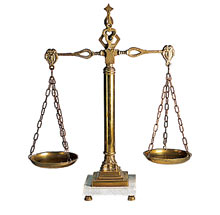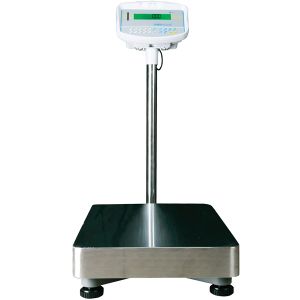Weighing Scales
Weighing Scale is a measuring instrument for determining the weight or mass of an object. A spring scale measures weight by the distance a spring deflects under its load. A balance compares the torque on the arm due to the sample weight to the torque on the arm due to a standard reference weight using a horizontal lever. Balances are different from scales, in that a balance measures mass , where as a scale measures weight . Weighing scales are used in many industrial and commercial applications, and products from feathers to loaded tractor-trailers are sold by weight. Specialized medical scales and bathroom scales are used to measure the body weight of human beings.
Balance
The balance also balance scale, beam balance and laboratory balance was the first mass measuring instrument invented.In its traditional form, it consists of a pivoted horizontal lever of equal length arms, called the beam, with a weighing pan, also called scale, scalepan, or bason , suspended from each arm . The unknown mass is placed in one pan, and standard masses are added to the other pan until the beam is as close to equilibrium as possible. In precision balances, a slider mass is moved along a graduated scale. The slider position gives a fine correction to the mass value. Although a balance technically compares weights, not masses, the weight of an object is proportional to its mass, and the standard weights used with balances are usually labeled in mass units.
Balances are used for precision mass measurement, because unlike spring scales their accuracy is not affected by differences in the local gravity, which can vary by almost 0.5% at different locations on Earth. A change in the strength of the gravitational field caused by moving the balance will not change the measured mass, because the moments of force on either side of the balance beam are affected equally. In fact, a balance will measure the correct mass even on other planets or moons, or any location that experiences a constant gravity or acceleration.
Very precise measurements are achieved by ensuring that the balance's fulcrum is essentially friction-free , by attaching a pointer to the beam which amplifies any deviation from a balance position; and finally by using the lever principle, which allows fractional masses to be applied by movement of a small mass along the measuring arm of the beam. For greatest accuracy, there needs to be an allowance for the buoyancy in air, whose effect depends on the densities of the masses involved.
The original form of a balance consisted of a beam with a fulcrum at its center. For highest accuracy, the fulcrum would consist of a sharp V-shaped pivot seated in a shallower V-shaped bearing. To determine the mass of the object, a combination of reference masses was hung on one end of the beam while the object of unknown mass was hung on the other end. For high precision work, the center beam balance is still one of the most accurate technologies available, and is commonly used for calibrating test weights. To reduce the need for large reference masses, an off-center beam can be used. A balance with an off-center beam can be almost as accurate as a scale with a center beam, but the off-center beam requires special reference masses and cannot be intrinsically checked for accuracy by simply swapping the contents of the pans as a center-beam balance can. To reduce the need for small graduated reference masses, a sliding weight called a poise can be installed so that it can be positioned along a calibrated scale. A poise adds further intricacies to the calibration procedure, since the exact mass of the poise must be adjusted to the exact lever ratio of the beam.
For greater convenience in placing large and awkward loads, a platform can be floated on a cantilever beam system which brings the proportional force to a noseiron bearing; this pulls on a stilyard rod to transmit the reduced force to a conveniently sized beam. One still sees this design in portable beam balances of 500 kg capacity which are commonly used in harsh environments without electricity, as well as in the lighter duty mechanical bathroom scale . The additional pivots and bearings all reduce the accuracy and complicate calibration; the float system must be corrected for corner errors before the span is corrected by adjusting the balance beam and poise. Such systems are typically accurate to at best 1/10,000 of their capacity, unless they are expensively engineered.
Some mechanical balances also use dials , a hybrid design with some of the accuracy advantages of the poise and beam but the convenience of a dial reading.
Analytical balance
An analytical balance is a class of balance designed to measure small mass in the sub-milligram range. The measuring pan of an analytical balance is inside a transparent enclosure with doors so that dust does not collect and so any air currents in the room do not affect the balance's operation. This enclosure is often called a draft shield. The use of a mechanically vented balance safety enclosure, which has uniquely designed acrylic airfoils, allows a smooth turbulence-free airflow that prevents balance fluctuation and the measure of mass down to 1 μg without fluctuations or loss of product.Also, the sample must be at room temperature to prevent natural convection from forming air currents inside the enclosure from causing an error in reading. Single pan mechanical substitution balance maintains consistent response throughout the useful capacity is achieved by maintaining a constant load on the balance beam, thus the fulcrum, by subtracting mass on the same side of the beam to which the sample is added.

